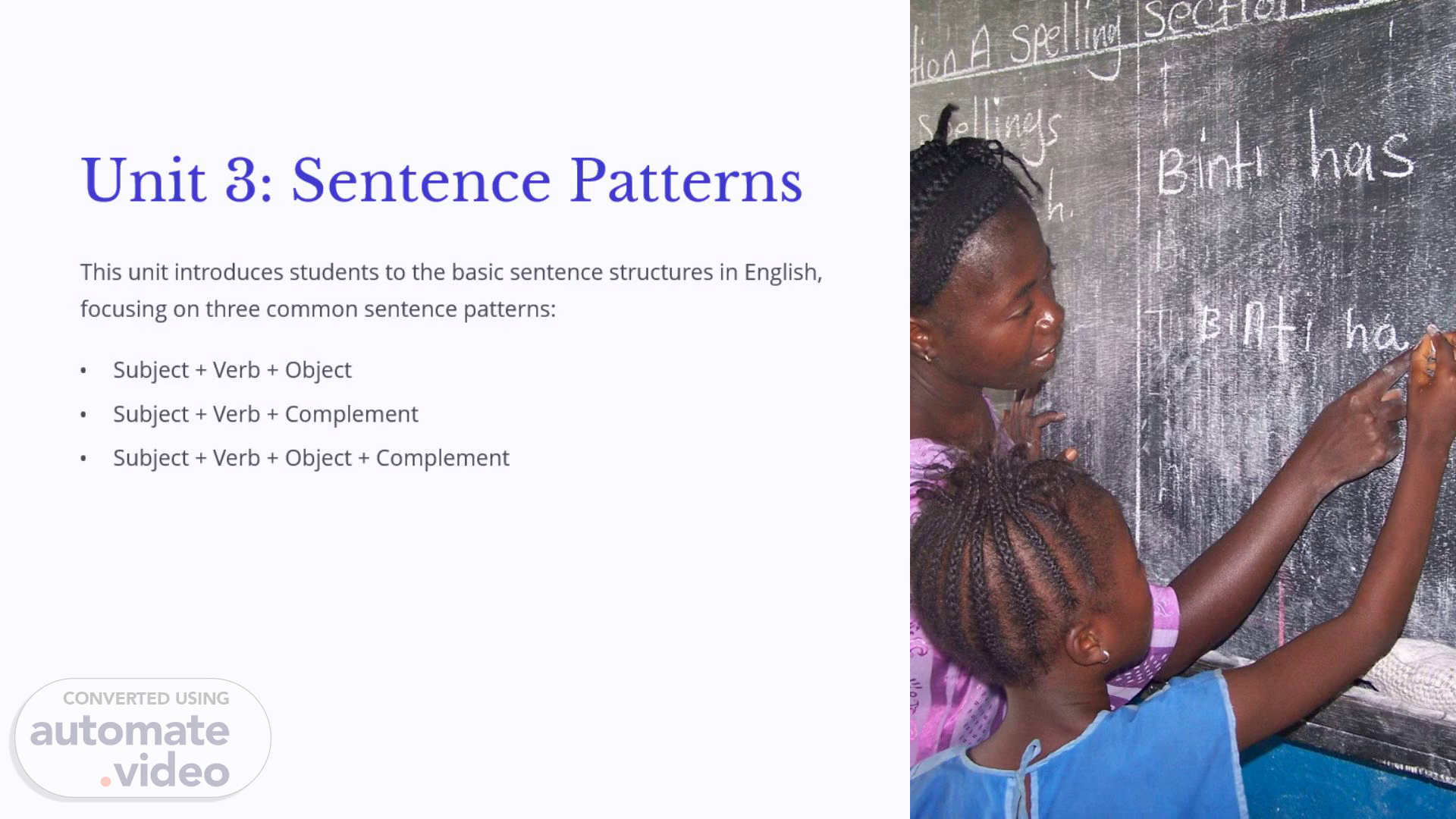Scene 1 (0s)
[Virtual Presenter] This slide introduces the key sentence patterns we'll be covering in Unit 3 The three main patterns are: Subject + Verb + Object Subject + Verb + Complement Subject + Verb + Object + Complement Mastering these core sentence structures will help learners build grammatically correct English, both in writing and speaking Understanding these patterns is a fundamental building block for developing strong English language skills We'll dive into examples and practice exercises for each of these patterns in the upcoming lessons The goal is for students to feel confident constructing a variety of sentence types by the end of this unit.
Scene 2 (46s)
[Audio] The slide introduces the Subject-Verb-Object (SVO) sentence structure, which is one of the most common in English. The subject is the person, thing, or idea performing the action. The verb is the action or state of being. And the object is the receiver of the action. I'll provide two examples to illustrate this structure: "She kicked the ball." Here, "she" is the subject, "kicked" is the verb, and "the ball" is the object. "John reads books." In this case, "John" is the subject, "reads" is the verb, and "books" is the object. The key is to remember the three core elements - subject, verb, and object - and how they work together to form a complete sentence..
Scene 3 (1m 26s)
[Audio] The slide introduces the subject-verb-complement (SVC) sentence structure In this structure, the verb is followed by a complement that completes the meaning of the sentence The complement usually refers to the subject and helps describe it further I'll provide two examples to illustrate this structure: Example 1: "She is a teacher." The subject is "She", the verb is "is", and the complement "a teacher" describes the subject. Example 2: "The cake smells delicious." The subject is "The cake", the verb is "smells", and the complement "delicious" describes the subject..
Scene 4 (2m 0s)
[Audio] The SVOC structure includes both an object and a complement, providing more detailed information about the object The object is the receiver of the action, while the complement gives additional details about the object Let's look at some examples to see how this structure works In the first example, "the lesson" is the object, and "interesting" is the complement that describes the object In the second example, "him" is the object, and "their leader" is the complement that describes the object Understanding the SVOC structure is important for constructing clear and detailed sentences.
Scene 5 (2m 32s)
[Audio] This slide introduces the three main sentence structures in English: SVO, SVC, and SVOC. For each structure, we have two clear example sentences that demonstrate the subject, verb, object, and complement. The visual icons and images help reinforce the different sentence structures and make them easy to understand. I'll walk through each example, emphasizing the key components of the sentence and how they fit into the overall structure. This slide provides a solid foundation for practicing and applying these sentence structures in writing and speaking..
Scene 6 (3m 8s)
[Audio] This slide presents 3 multiple choice questions on sentence structure The first question asks which sentence follows the Subject + Verb + Object structure The correct answer is B) He bought a car The second question asks which sentence follows the Subject + Verb + Complement structure The correct answer is B) She feels happy The third question asks which sentence follows the Subject + Verb + Object + Complement structure The correct answer is B) The teacher called the students tired These questions test the audience's understanding of basic sentence structures in English.
Scene 7 (3m 46s)
[Audio] This slide provides a list of additional resources for learning about sentence structure in English. The BBC Learning English website has excellent lessons and practice on different sentence structures. The Grammarly blog has helpful articles that explain sentence structure concepts and offer tips for improving. The Cambridge Grammar of English is a comprehensive reference guide covering English grammar, including sentence patterns. The Purdue OWL website has a useful section on sentence structure, with explanations and exercises. I'd encourage the audience to explore these resources to deepen their understanding of English sentence structure..
Scene 8 (4m 26s)
[Audio] • The conclusion summarizes the key benefits of mastering basic sentence structures in English • Effective communication is achieved through clear, well-structured sentences • Improved writing skills come from understanding and applying these core sentence patterns • Precise language use is enabled by proper subject-verb-object/complement construction • Confident speaking is built on a foundation of grammatically correct, fluent sentence formation • Mastering these fundamental sentence structures is essential for learners to communicate effectively in English.
